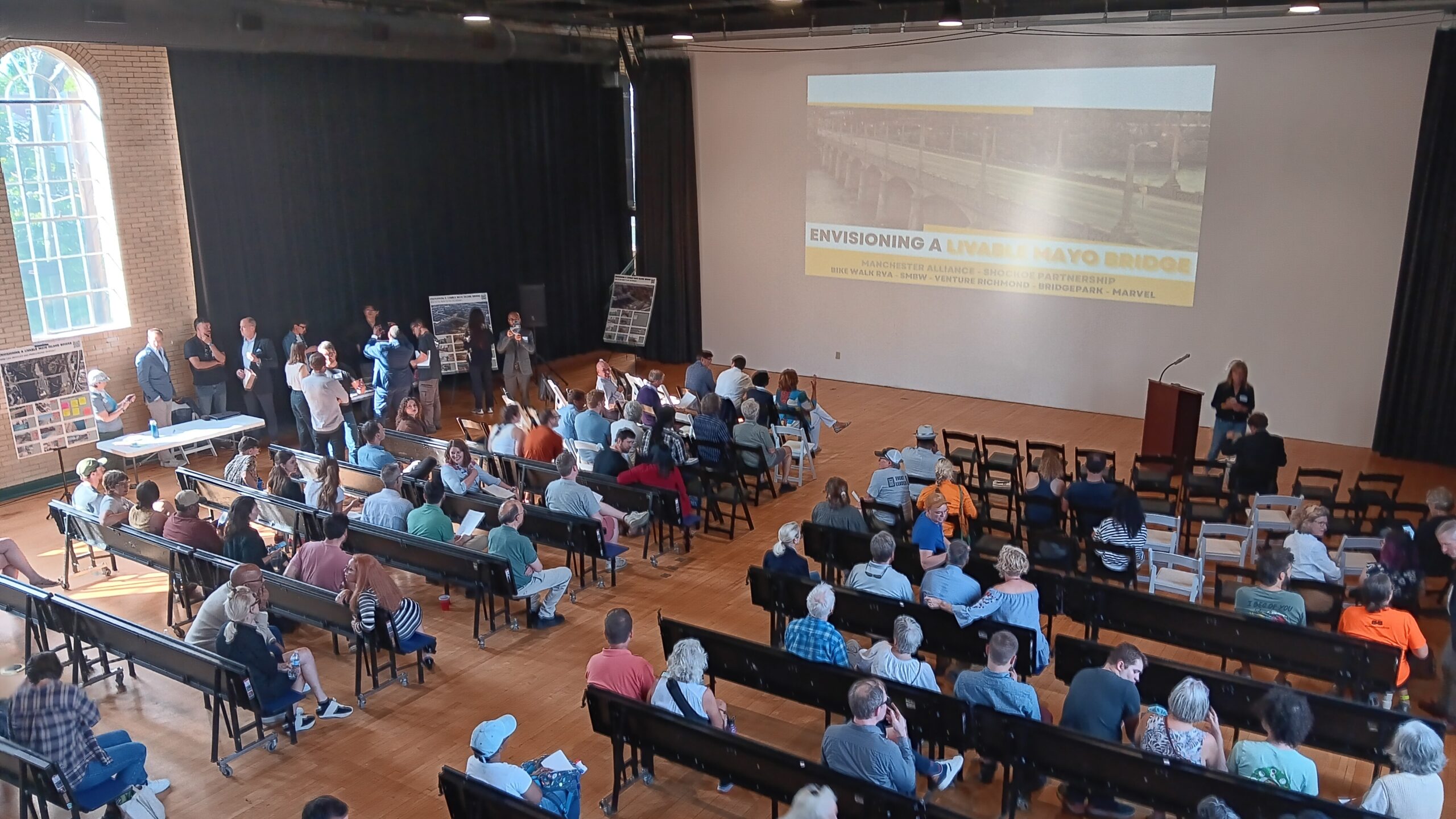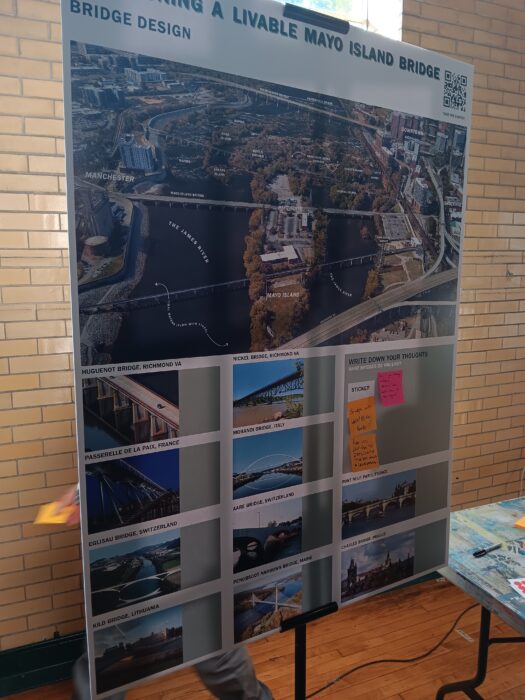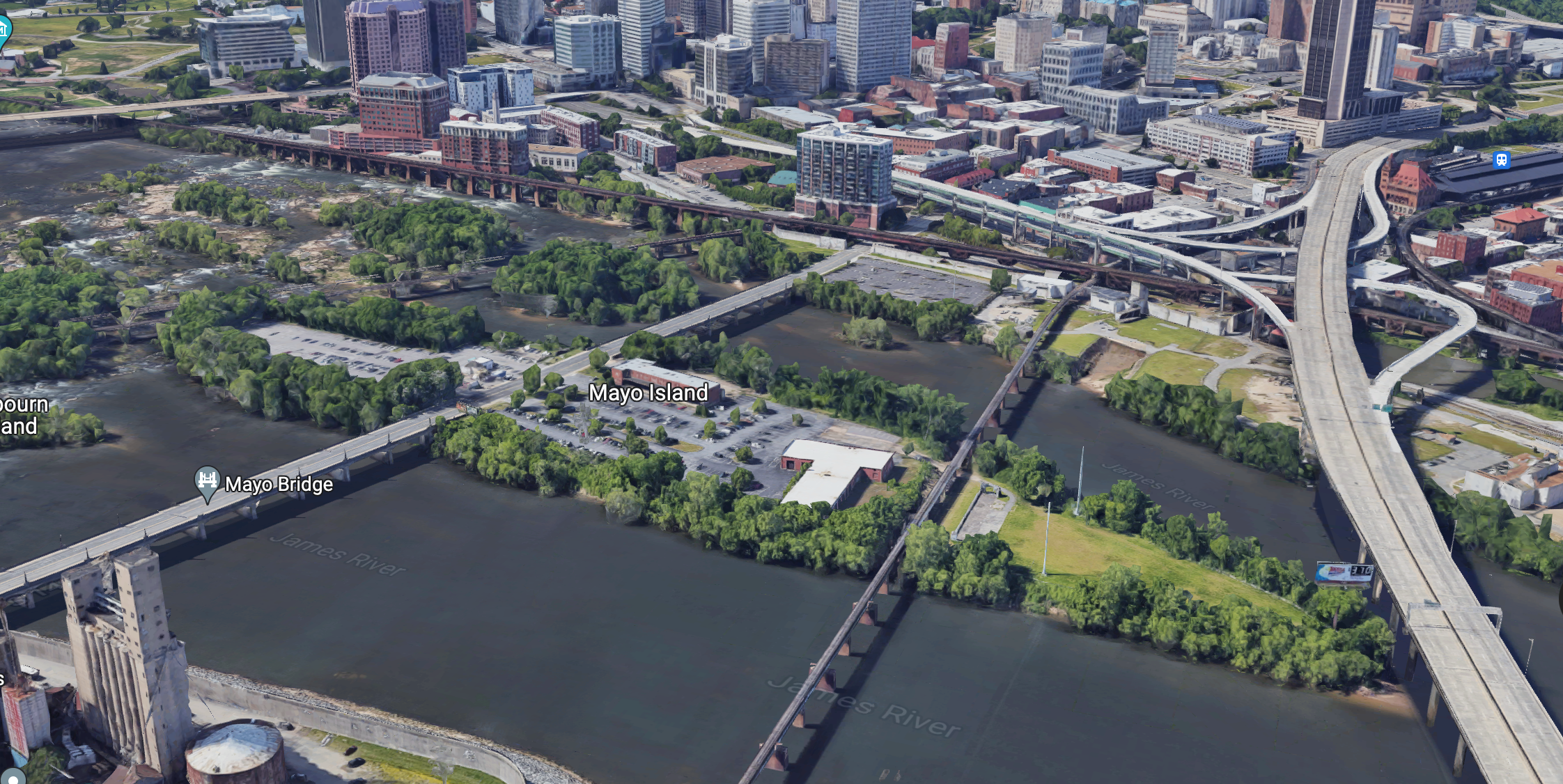
More than 150 people gathered Monday for a discussion around the replacement of the Mayo Bridge. (Mike Platania photo)
A community meeting was held Monday night to field public input on what a new Mayo Bridge could look like.
Held jointly by the Manchester Alliance, Shockoe Partnership and Bike Walk RVA, the meeting centered on the upcoming replacement of the 111-year-old bridge that connects Shockoe to Manchester via 14th Street. It also bisects Mayo Island, which the City of Richmond now owns and plans to turn into a park.
The bridge replacement project has been in the works for a few years now. It was initially set to include a replacement of the top of the bridge (the superstructure), but the scope of the project expanded earlier this month when the Virginia Department of Transportation announced that a recent analysis found that the bridge’s piers (the substructure) will likely need to be replaced as well.
Replacing the piers or relocating the bridge is likely to significantly increase the initial $90 million budget for the project, which the state and city already have earmarked, but it also opens up more creative options on how the new bridge – or bridges – could be designed.
Monday’s meeting was held at Studio Two Three’s new home in Manchester before a crowd of around 170. Those in attendance included the City’s Chief Administrative Officer Lincoln Saunders and Councilwoman Ellen Robertson.
Saunders told the crowd that there were still some unknowns regarding the overall state of the piers, and that the city is looking to the community to contribute ideas before the bridge design process gets underway.
“There’s additional analysis and scoping that needs to be done to see what the best alternative is, be that a potentially new structure on a different routing, or a new, full bridge replacement on the existing geolocation,” Saunders said. “We don’t know what those answers are going to be yet.”
The defects VDOT recently found in the existing piers would reduce a new superstructure’s lifespan from the 75-100 year range to around 25, city bridge engineer John Sang Kim said.
While the current Mayo Bridge has two lanes of traffic heading in each direction with sidewalks on either side, Charles Macfarlane, a local developer who leads the Shockoe Partnership, said the organization and the Manchester Alliance would like to see the new bridge include more pedestrian access, an idea he said is supported by both the Shockoe Small Area Plan and Richmond 300 master plan.
“We believe it should be one lane in each direction and the rest should be for pedestrians, recreation and bikes,” Macfarlane said, drawing applause from the crowd. “The heavy trucks, the big trucks, the loud trucks – all of those can go on the other bridges. We believe this should be a community bridge.”
Attendees also said the future park on Mayo Island should be a consideration, and Councilwoman Robertson said the new Mayo Bridge needs to be thought of as “the heart of the park.”

Examples of bridges from as far away as Prague and France were presented as possible design inspirations for the new Mayo Bridge.
“We have a park that the city owns that’s in the middle of this bridge, and whatever we do with this bridge…everybody needs to be able to get to the park and park on either side of the bridge,” Robertson said. “As we think about the design of this bridge, I like the idea of it being a livable bridge, but I also want it to also be thought of as an extension of the park.”
While questions of future funding hurdles and exact bridge route remain, Bike Walk RVA director Brantley Tyndall encouraged the public to think creatively in giving the city and VDOT ideas of what the new Mayo Bridge could include.
“We get to work with a blank slate now,” Tyndall said. “Let’s think about what we actually want to accomplish, without being constrained.”
Added Macfarlane: “This is an opportunity to do something really marvelous from an architectural standpoint.”
Examples of innovative new bridge designs were offered at the meeting by Ted Elmore, president of local nonprofit BridgePark, which is looking to also reimagine the Manchester Bridge.
Elmore pointed to Indianapolis’s Henry Street bridge as one that accommodates both car and pedestrian traffic, and The Providence River Pedestrian Bridge in Rhode Island as a project that converted an aging, existing bridge into a pedestrian-only promenade. Whether the Mayo Bridge could support such a conversion is still to be determined, Elmore said, but it’s worth exploring.
“From a community perspective, it’s a once-in-a-lifetime opportunity to build a whole new bridge the way they want,” Elmore said.
VDOT is currently conducting a survey to gather public input on the new Mayo Bridge’s design.
Construction isn’t likely to begin until 2027, and the buildout could span years. Architecture firm SMBW and design studio Marvel Designs are part of the planning team for the bridge project.
It will be the ninth time in the Mayo Bridge’s history that it’ll be replaced.
BridgePark’s Manchester Bridge project is still in the works, Elmore said, noting that it was bolstered by being along the Fall Line Trail, a new pedestrian trail that will run from Ashland to Petersburg.

More than 150 people gathered Monday for a discussion around the replacement of the Mayo Bridge. (Mike Platania photo)
A community meeting was held Monday night to field public input on what a new Mayo Bridge could look like.
Held jointly by the Manchester Alliance, Shockoe Partnership and Bike Walk RVA, the meeting centered on the upcoming replacement of the 111-year-old bridge that connects Shockoe to Manchester via 14th Street. It also bisects Mayo Island, which the City of Richmond now owns and plans to turn into a park.
The bridge replacement project has been in the works for a few years now. It was initially set to include a replacement of the top of the bridge (the superstructure), but the scope of the project expanded earlier this month when the Virginia Department of Transportation announced that a recent analysis found that the bridge’s piers (the substructure) will likely need to be replaced as well.
Replacing the piers or relocating the bridge is likely to significantly increase the initial $90 million budget for the project, which the state and city already have earmarked, but it also opens up more creative options on how the new bridge – or bridges – could be designed.
Monday’s meeting was held at Studio Two Three’s new home in Manchester before a crowd of around 170. Those in attendance included the City’s Chief Administrative Officer Lincoln Saunders and Councilwoman Ellen Robertson.
Saunders told the crowd that there were still some unknowns regarding the overall state of the piers, and that the city is looking to the community to contribute ideas before the bridge design process gets underway.
“There’s additional analysis and scoping that needs to be done to see what the best alternative is, be that a potentially new structure on a different routing, or a new, full bridge replacement on the existing geolocation,” Saunders said. “We don’t know what those answers are going to be yet.”
The defects VDOT recently found in the existing piers would reduce a new superstructure’s lifespan from the 75-100 year range to around 25, city bridge engineer John Sang Kim said.
While the current Mayo Bridge has two lanes of traffic heading in each direction with sidewalks on either side, Charles Macfarlane, a local developer who leads the Shockoe Partnership, said the organization and the Manchester Alliance would like to see the new bridge include more pedestrian access, an idea he said is supported by both the Shockoe Small Area Plan and Richmond 300 master plan.
“We believe it should be one lane in each direction and the rest should be for pedestrians, recreation and bikes,” Macfarlane said, drawing applause from the crowd. “The heavy trucks, the big trucks, the loud trucks – all of those can go on the other bridges. We believe this should be a community bridge.”
Attendees also said the future park on Mayo Island should be a consideration, and Councilwoman Robertson said the new Mayo Bridge needs to be thought of as “the heart of the park.”

Examples of bridges from as far away as Prague and France were presented as possible design inspirations for the new Mayo Bridge.
“We have a park that the city owns that’s in the middle of this bridge, and whatever we do with this bridge…everybody needs to be able to get to the park and park on either side of the bridge,” Robertson said. “As we think about the design of this bridge, I like the idea of it being a livable bridge, but I also want it to also be thought of as an extension of the park.”
While questions of future funding hurdles and exact bridge route remain, Bike Walk RVA director Brantley Tyndall encouraged the public to think creatively in giving the city and VDOT ideas of what the new Mayo Bridge could include.
“We get to work with a blank slate now,” Tyndall said. “Let’s think about what we actually want to accomplish, without being constrained.”
Added Macfarlane: “This is an opportunity to do something really marvelous from an architectural standpoint.”
Examples of innovative new bridge designs were offered at the meeting by Ted Elmore, president of local nonprofit BridgePark, which is looking to also reimagine the Manchester Bridge.
Elmore pointed to Indianapolis’s Henry Street bridge as one that accommodates both car and pedestrian traffic, and The Providence River Pedestrian Bridge in Rhode Island as a project that converted an aging, existing bridge into a pedestrian-only promenade. Whether the Mayo Bridge could support such a conversion is still to be determined, Elmore said, but it’s worth exploring.
“From a community perspective, it’s a once-in-a-lifetime opportunity to build a whole new bridge the way they want,” Elmore said.
VDOT is currently conducting a survey to gather public input on the new Mayo Bridge’s design.
Construction isn’t likely to begin until 2027, and the buildout could span years. Architecture firm SMBW and design studio Marvel Designs are part of the planning team for the bridge project.
It will be the ninth time in the Mayo Bridge’s history that it’ll be replaced.
BridgePark’s Manchester Bridge project is still in the works, Elmore said, noting that it was bolstered by being along the Fall Line Trail, a new pedestrian trail that will run from Ashland to Petersburg.




Mr. Kim has dramatically changed his analysis of the bridge piers. He reported less than two years ago that they were good for another “four hundred years” (by my memory, which could be faulty). Now, it’s 25 years. Although I’d like to see all auto traffic removed from the bridge, I’d settle for Charles’ recommendation of one lane in each direction serving automobiles only. No truck traffic! That compromise would probably result in such long backups at each end of the bridge anyway that all vehicles would eventually find better ways to cross the river, a “natural selection” of sorts… Read more »
That first part is pretty interesting Bruce — I wonder what changed…. did they do some kind of ultrasound on the piers that they did not before?
Honestly, get all automobile traffic off this bridge, this would help significantly reduce traffic in Downtown Manchester area and just send the car traffic to I-95 or the 9th St bridge. I would probably close the Nickel bridge too and give that the same treatment as the Mayo bridge.
I’m super in favor of reducing car traffic by adding ped/bike/transit access, but I’m not sure I’m on board for removing all car access from the bridge. The primary reason is this is a critical transit route primarily for the GRTC route 1. As someone who has lived in both Shockoe and Manchester, I think I’d be in favor of keeping one lane each way and giving it wide protected bike lanes, wider sidewalks, raised crosswalks in the middle at the bus stop, etc. Eventually you could still make the car lanes transit-only if you want. But I’m persuadable.
I’m not sure if the down votes are a result of your suggestion to completely close then Mayo Bridge to vehicular traffic or to close Nickel Bridge to it. Nickel was recently repaired and is well above flood plain levels. It doesn’t serve similar truck traffic nor does it have substantially dense residential populations on each side of it.
You can’t put all of these new people in Manchester and take away the bridge, it sounds good but it will never work.
Could be…. I LIKE the idea of pedestrian bridges of course, and of course I like the idea of lots of space reserved for walking and biking and limited car traffic too if it is necessary, which I SUSPECT it will be — as you say, all this density means that having people self shunt to crowd other bridges, which would take time and gasoline and generally make Richmond less interconnected.
PS, I LIKE the Indianapolis bridge idea lots of protected space adjacent to the cars — don’t need those big rings though — they look superfluous and a little annoying.
By removing automobile traffic from the Mayo bridge, you would be taking away easy access between Manchester and Downtown/Shockoe Bottom (using I-95 is ridiculous notion). Take it down to one lane if you must, but Hull Street has become an irritating bottleneck for commuters since its transition to one lane.
You don’t have to use I95, use the 9th Street bridge.
I hope I am alive by the time this is finished.
I heard that, Lee! Same here. I’m 61 and I’m starting to question whether I’ll live long enough to see these kinds of projects ever come to pass, based on the track record of past performance.
I don’t care what the city’s park wants to do ,keep it 2 lanes ea way with sidewalks.Raise the speed limit and forget the bike lanes.
It sounds nice but closing it altogether or reducing it to one lane each direction is going to have serious implications for other roads. A lot of the traffic crossing on 14th is running between Downtown/eastern Henrico and numerous neighborhoods off Hull Street. 95 really isn’t an option because it only dumps you off onto to a one lane Maury St which currently moves traffic poorly. Broad St in Shockoe Bottom is already gridlocked due to bridge work and VCU surface lots and associated pedestrians which means Main St. would have to take the majority of extra traffic over to… Read more »
Since some demand like Creative Ideas, I give you this: Erect tall “treehouses” on the Island and then connect to both Manchester and Shockoe via ROPE BRIDGES. No bikes. Make them sway to improve proprioception and enhance the Sense of Adventure. Next, see those other Islands to the west? Yep, build more tree forts and connect those Islands via more rope bridges. Ready. Set, Explore. You won’t need any pesky piers that will need to be piled deep into the Petersburg Granite — but the “treehouses” will need to be but at least you wont need caissons and the supports… Read more »